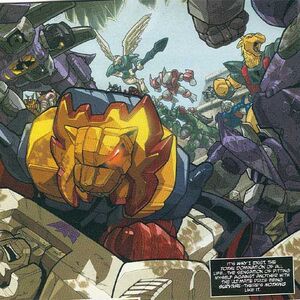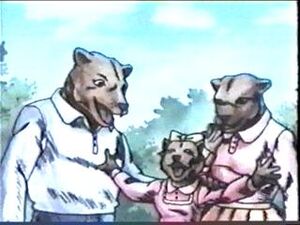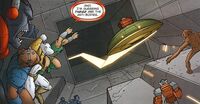
Adorably vicious
The Beastformers toy-line, developed jointly by Hasbro and Takara in 1986, was released as part of the Japanese Headmasters series (in 1987) and even made appearances within the series' cartoon and manga.
The US/European version of the line, called Battle Beasts was --until recently-- fictionally unconnected to Transformers.
- Portugese name: Bestias Combate
- French-Canadian name: Comba Nimaux
- French name: Les Dragonautes
Fiction
Headmasters cartoon

A bucolic Sylvanian... er, Beastformer family before the Decepticons invaded
The Autobots come into contact with two refugee Beastformers who have come to seek help. They say that their world, planet Beest, was a happy and peaceful one ruled by a just hereditary monarchy of lions (what else?) until the Decepticons invaded and helped the enemy forces of Alligatoron take control. To all appearances, this tragedy changed their society from a girls' toy brand to a boys' toy brand. The Autobots traveled to Beest in Fortress Maximus and helped the good Beastformers free planet Beest from Decepticon tyranny. Rodimus Prime left the Monsterbots behind to protect the planet from any future Decepticon incursions.
After Scorponok blew up Cybertron and Rodimus Prime departed to find a new homeworld, the Monsterbots rejoined the Autobot forces under Fortress. This led to further suffering for the Beastformers as the Decepticons invaded again (see below) and Scorponok took many of them to the planet Zarak as slaves to build him a giant transtector. Smooth move, Monsterbots.
Headmasters manga
Once again, the Decepticons have teamed up with Alligatoron to take over planet Beest. The good Battle Beasts under the command of White Leo (with help from human-turned Battle Beast Cain) send for assistance from the Autobots, who arrive to help defeat the Decepticons and Alligatoron.
Dreamwave Generation 1 comics
While hunting down the rogue Predacons, Megatron's search brought him to planet Beest during the middle of a battle amongst the Beastformers.
DDP G.I. Joe vs. the Transformers comics

Beastformers acting as Unicron's antibodies.
In order to keep the planet-devouring chaos god Unicron from munching Earth, Flint and Cosmos traveled within the giant's body in order to deliver a devastating payload of metal-eating fungus to his brain. Flint and Cosmos were stalled by Unicron's antibodies, in the form of mind-controlled Beastformers. Flint and Cosmos fought past the Beastformers and defeated Unicron with the fungus. Whether this freed the enslaved Beastformers or not remains unclear. However, Joe Colton is charged with leading a mission to Unicron's dead body in order to bring assistance its residents (presumably the Beastformers).
Blackthorne Battle Beasts comics
The Battle Beasts did get some outside fiction in the US, in the form of a short-lived (four issues) Blackthorne comic book. Good luck finding it.
Toys
Battle Beasts/Beastformers are soft-plastic figurines of anthropomorphic animals in robotic armor, each about 1.5 inches tall, with posable arms and a unique weapon accessory. Their primary gimmick is the use of rubsigns. In the initial Takara releases, they came in Transformers-style boxes.
Their rubsigns were used to play a variation of "Rock-Paper-Scissors". Each Beast could have one of three "elements" revealed by the rubsign: Wood, Fire or Water. Wood beats Water, Water beats Fire, and Fire beats Wood. A rare fourth element, Sunburst ("Burstsun" in Japan), could beat any other, though this symbol was introduced late in the line. Since the symbols were heat-activated, it was impossible to determine what each toys' symbol was until the toys were freed from their packaging. (Reportedly, only White Leo was available as a "Burstsun" warrior in Japan.) The Hasbro line packaged them as two-packs with randomized pairings, while the Takara series had individual boxes with bio cards.
Series 1 (1987)
Packaged in Transformers-style boxes, the initial Beastformers were divided between the Autobot and Decepticon factions on the basis of whether their species was an endothermic vertebrate (mammal or bird) or... well, anything else. The one exception was the Decepticon Devilbat.
Autobot
- 1 - White Leo / Pirate Lion
- 2 - Big Serow / Deer Stalker
- 3 - Goldar / Ferocious Tiger
- 4 - Flykick / Colonel Bird
- 8 - Elephan / Sledgehammer Elephant
- 9 - Graysharp / Rocky Rhino
- 10 - Gray Ox / Roamin' Buffalo
- 11 - Battle Bear / Grizzly Bear
- 13 - Bonga / Gargantuan Gorilla
- 14 - Wild Thunder / Swiny Boar
- 16 - B-Fox / Sly Fox
- 18 - Yellow Giraffe / Rubberneck Giraffe
- 19 - Hedgehog / Prickly Porcupine
- 22 - Rabbit Kid / Hare Razing Rabbit
- 21 - Bowdog / Danger Dog
- 23 - Bluehorse / Sir Sire Horse
- 24 - Giada / War Weasel
- 25 - Violet Horn / Bloodthirsty Bison
- 26 - Bomb Sheep / Bighorn Sheep
Decepticons
- 5 - Killer Fish / Killer Carp
- 6 - Snake Bomb / Triple Threat Snake
- 7 - Drillfrog / Horny Toad
- 12 - Devilbat / Blitzkrieg Bat
- 15 - Alligatoron / Gruesome Gator
- 17 - Black Turtle / Hardtop Tortoise
- 20 - Badshark / Sawtooth Shark
- 27 - Deathspider / Webslinger Spider
- 28 - Crab Hit / Crusty Crab
Series 2 (1987)
At this point, Beastformers boxes ceased to use the Autobot and Decepticon symbols and faction-coded red and purple backgrounds. They were still divided between Autobot and Decepticon factions, with appropriate faction insignia on the bio cards included in their boxes. The Autobot Beastformers were still exclusively mammals and birds, while the Decepticon Beastformers welcomed owls and a variety of mammals into their ranks. And these are supposed to be the villains.
Autobot
- 31 - Power Jaguar / Jaded Jag
- 32 - Strong Hippo / Humongous Hippo
- 33 - Wave Moose / Major Moose
- 35 - Jungaroo / Kickback Kangaroo
- 37 - Sea Iron / Wolfgang Walrus
- 39 - Dark Raccoon / Dragoon Racoon
- 41 - Smile Duck / Run Amuck Duck
- 42 - Underground / Miner Mole
- 44 - Beavup / Eager Beaver
- 47 - Yellow Camelus / Hunchback Camel
- 48 - Polar Battle Bear / Pillaging Polar Bear
- 49 - Flying Attacker / Squirely Squirrel
- 50 - Platinum Tiger / Sabre Sword Tiger
- 51 - Bullhorn / Bludgeonly Bulldog
Decepticon
- 29 - Iguanamons / Icky Iguana
- 30 - Brown Gyro / Armored Armadillo
- 34 - Green Chameles / Delta Chameleon
- 36 - Red Octo / Octillion Octopus
- 38 - Scout Mouse / Powerhouse Mouse
- 40 - Power Nozzle / Antic Anteater
- 43 - Cuttledeep / Cutthroat Cuttlefish
- 45 - Junior Dragon / Slasher Seahorse
- 46 - Night Owl / Knight Owl
- 52 - Ultragas / Pew-Trid Skunk
Series 3 (1987)
With the third wave release, the rubsigns were reworked so they featured full-color illustrations, rather than the black-on-mood-ring-colors of the old signs. All Series 1 Beastformers were repackaged to fit with the new Beastformers brand and given the updated rubsigns. The Series 2 Beastformers were also rereleased with the updated rubsigns in Series 3 boxes. Numerous multi-packs --with exclusive variations-- were released in Japan as well.
Vehicles were also introduced to the line, motorized "Battle Chariots" and transforming "Battle Bases" that unfolded into large playsets.
Autobots
- 53 - Strong Panda / Panzer Panda
- 55 - Koala Gray / Killer Koala
- 58 - Dream-Eater / Torrential Tapir
- 60 - Baboon / Manic Mandrill
- 61 - Dog Hunter / Pixilated Pointer
- 62 - Buupink / Pillager Pig
- 63 - Laser Cock / Rowdy Rooster
- 64 - Musk-Horn / Musky Ox
- 66 - Slo / Slowpoke Sloth
- 67 - Earthhog / Ardent Aardvark
- 68 - White Cow / Bodacious Bovine
- 69 - Zebra Ball / Zealot Zebra
- 71 - Duck Diver / Diving Duckbill
- 73 - 'Mingo Kid / Frenzied Flamingo
- 74 - Little Serow / Fleet-Footed Antelope
- 75 - Peguinis / Pungnacious Penguin
- 76 - Udan / Osified Orangutan
Decepticons
- 54 - Shield Dragon / Leapin' Lizard
- 56 - Demonkey / Tarsier Tyrant
- 57 - Black Jaguar / Black Panther
- 59 - Cobrander / King Cobra
- 65 - Pangol / Tanglin' Pangolin
- 70 - Eagle Killer / Harrier Hawk
- 72 - Crowmax / Crooked Crow
Battle Chariots
- Battling Big Horn
- Battling Deer Stalker
- Battling Tearin' Tiger
Battle Bases
- Red Phoenix
- Shocking Shark
- Wood Beetle
Laser Beasts (1988)
An evolution of the gimmick was planned for both sides of the world, replacing the rubsigns with clear marbles that would reveal their element when looked through into a light source. The US/Europe version of these toys, dubbed the Battle Beasts Shadow Warriors, never made to it wide release, though packaged samples of the toys have been uncovered. In Japan, the entire range made it to retail, under the name Laser Beasts, likely named as such due to the combination of their light-based gimmick, and that the melee weapons of old were replaced with blaster-rifles. However, the Laser Beasts came out well after the Beastformers had removed all their ties to Transformers (and, as such, will not be covered extensively on this wiki).
